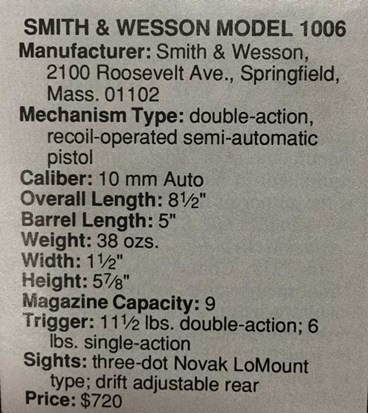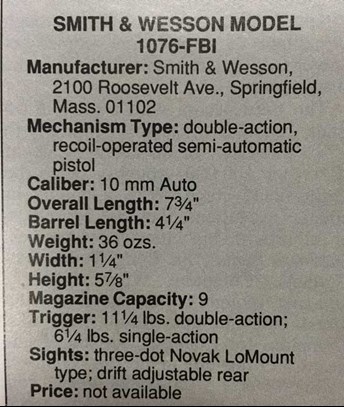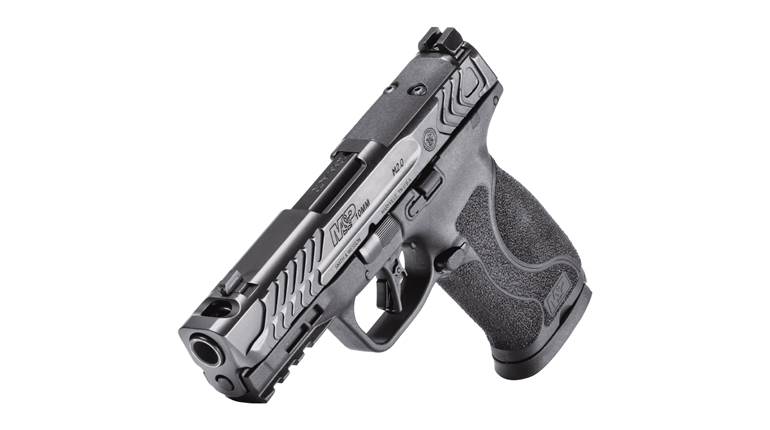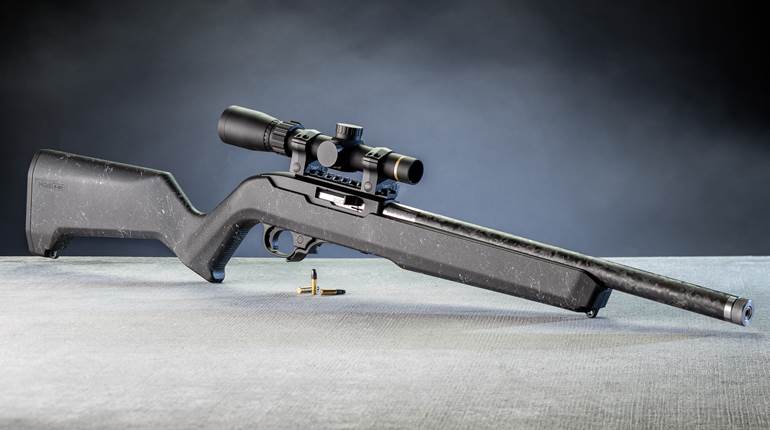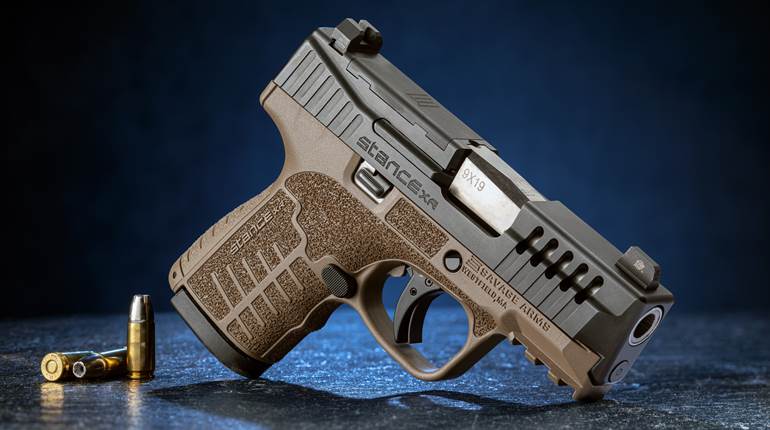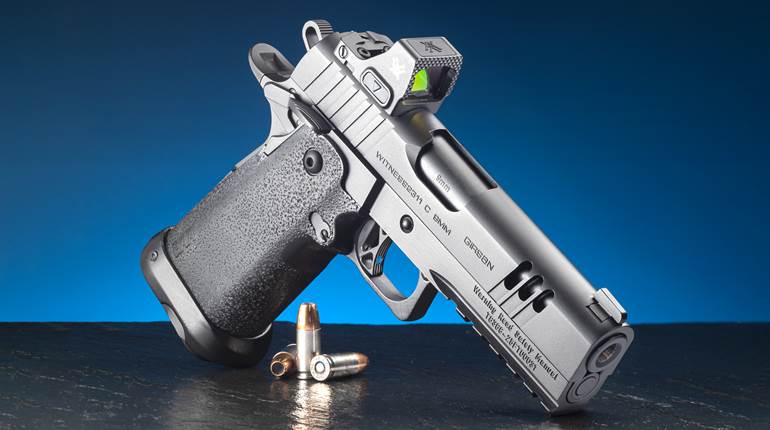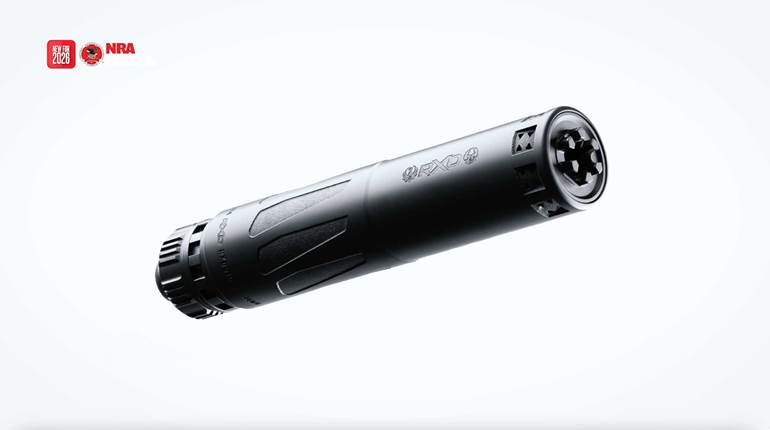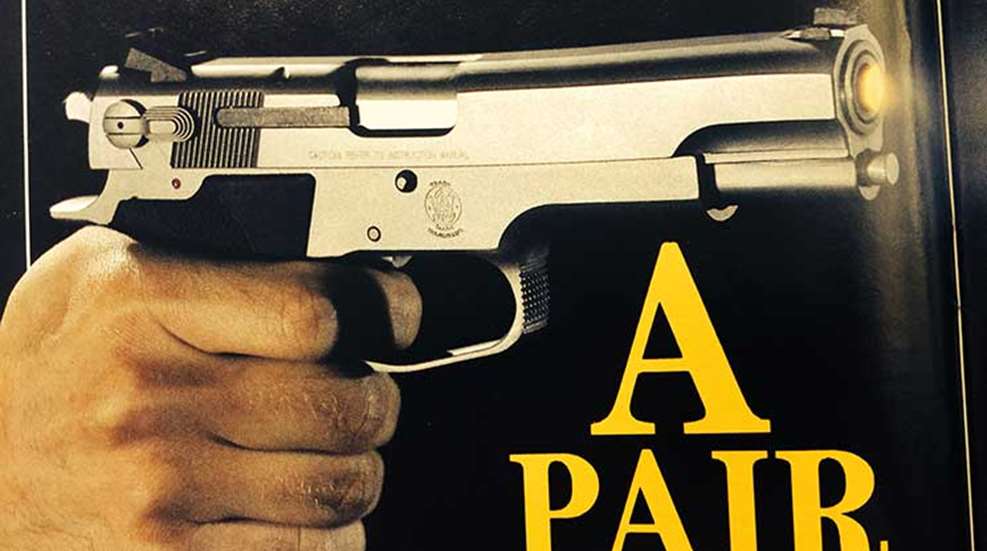
Originally published in American Rifleman, June, 1990
By Charles Petty
When news came late last year that the FBI was adopting the 10 mm Auto for its standard-issue weapon, it was one of the great surprises of recent law enforcement firearms history. The 10 mm cartridge has a checkered past that began with the ill-fated Bren Ten of the early ‘80s, and it wasn’t until Colt announced the Delta Elite that the cartridge’s popularity began to ascend. When I first wrote about the 10 mm Auto (July 1988, p. 38), I was impressed with the cartridge but lamented that there wasn’t available a double-action 10 mm pistol.
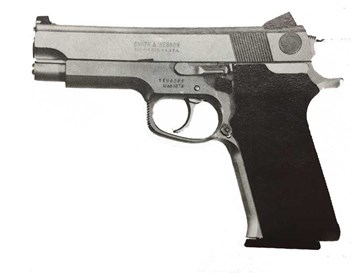
Events have evolved to propel the 10 mm into the limelight. Foremost of these was the recent FBI ammunition study that established the cartridge as one of the most reliable rounds for law enforcement. The study (see accompanying sidebar) determined that a reduced 10 mm Auto load was equal to the best available .45 ACP ammunition and superior to the 9 mm for the FBI’s specific needs.
The study has brought us full circle…back to the original reason the government chose the .45 as a service pistol in the first place. Put simply, big heavy bullets are more effective than light fast ones. In fact, increasing velocity may actually reduce performance.
When this was “discovered,” the FBI had no current plans to adopt a new pistol, although there was the widespread perception within the Bureau that a semi-automatic was coming.
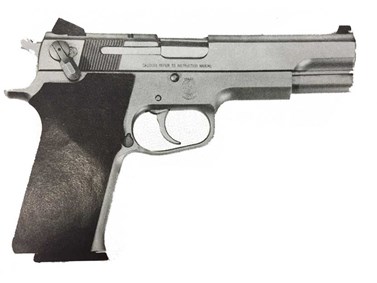
In the wake of the 1986 Miami shooting incident (see "The FBI Ammo Tests"), there was general concern, shared at the FBI's highest levels, that agents needed something better. Although there were no funds budgeted for a new pistol, John Hall, chief of the Firearms Training Unit (FTU) at the FBI Academy in Quantico, Va., approached FBI Director William Sessions with the results of the ammunition tests.
“If you find the right gun, we'll find the money,” said Sessions. By transferring funds appropriated for other projects, money was found to equip all FBI agents with a sidearm designed to the Bureau's specifications.
The FTU staff felt that no currently available pistol met its needs and issued a general request for samples. After testing of pistols submitted by several manufacturers, Smith & Wesson was awarded a contract for 9,000 pistols to be delivered over a period of three years.
The fact that S&W was working on a model for the FBI was a closely guarded secret. In the early stages only a handful of people at S& W knew anything about it. S&W converted standard 4506 and 4516 pistols to I 0 mm and submitted them to the FBI.
The pistol that evolved through a series of meetings, samples and testing is now known as the Model 1076. But it began as an open book. The discussions centered on design features the FBI wanted.
For example, the FBI didn't like the shape of the trigger guard used on the Model 4506 and preferred the style used on the 4516. “That was a simple tape change for us,” (on its computer-controlled machines) said S&W Vice President Kevin Foley.
Another feature the FBI insisted on was a frame-mounted decocking lever. This was not found on any S& W models, but as a part of its Automatic Improvement Program (AIP) process, the engineering department had designed one. The FBI's request provided the incentive for S&W to go ahead and produce the tooling required to make it.
The heart of the new FBI 10 mm pistol is a load that was conceived as a result of the ammunition tests. Full-charge 10 mm ammunition performed extremely well in the testing, but staffers agreed that recoil and muzzle blast were too severe for everyday use.
The agents discovered that a reduced handload using the 180-gr. Sierra jacketed hollow point bullet (JHP) at 950 f.p.s. performed almost as well as fullcharge I 0 mm ammunition. As it wasn't practical to handload the volume of ammunition needed for large-scale testing and development, Federal Cartridge Co. was asked to provide 10 mm ammunition loaded to FBI specifications.
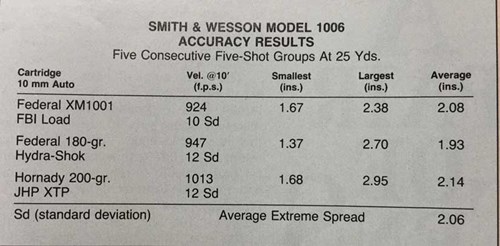
At first the project was cloaked in secrecy, but when the FBI published the first results of its testing in May 1989, the floodgates opened.
The small wave of interest in the 10 mm has since turned into a groundswell that will soon see .40 cal. pistols everywhere. They might alter the enthusiasm for high-capacity 9 mm pistols that has dominated the thinking of law enforcement agencies for the last 10 years.
With all this as preamble, let me now introduce two new double-action pistols from S&W. The first, the Model 1076-FBI, is designed to the Bureau's specifications and differs from its stablemate, the Model 1006, in a number of features. 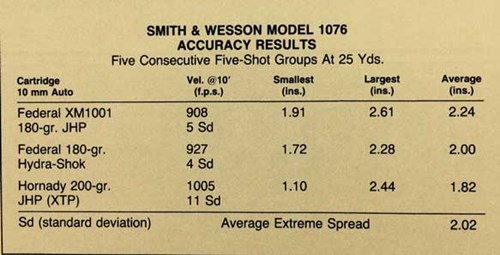
Most notable are a decocking lever (there is no need for a hammer-drop safety in this case) and the slightly shorter 4 ¼”' barrel length. The 1076-FBl features tritium night sights installed in the now familiar three-dot pattern. The Novak-design rear sight is standard.
The gun also lacks the ubiquitous magazine safety, so it will not be sold on the commercial market. A civilian version, also known as the Model 1076 and equipped with a magazine safety, will be produced at some time in the future. Night sights will be an extra-cost option.
The Model 1006 may already be seen on dealer's shelves. Both pistols have been subtly changed to accommodate the heavier recoil of the 10 mm Auto cartridge, and it is important to note that even though the 1076-FBI will be used largely with the reduced 10 mm load, it, just like the 1006, is designed with full-charge ammunition in mind.
Without comparing 9 mm and 10 mm pistols side-by-side, it's hard to see where the changes have been made, but both slide and frame of the 10 mm pistols are heavier. In order to maximize parts commonality, the heavier slide and frame are now being used on the 4506 and 4516 .45 cal. models as well.
When I first shot the prototype Model 1006, it was with full-charge Norma ammunition, and I was favorably impressed with the way the pistol handled recoil.
I had found that some 10 mm pistols had a particularly annoying recoil that tended to twist the gun in the hand. Neither the 1006 nor the 1076 feel that way to me, even when fired with hot ammo. The reduced FBI load is most pleasant to shoot. The recoil is quite comparable, as it should be, to .45 hollow-point loads.
I think the story of these new 10 mm pistols is almost as much about ammo as it is guns, for the repercussions of the FBI ammo study are already producing changes in available ammunition. While Federal's XMIOOI 10 mm FBI load is not sold commercially, its Premium line now includes a 180-gr. Hydra-Shok bullet loaded to match the FBI ammunition. Winchester has also added an FBI-specification load in its Ranger line of law enforcement ammunition.
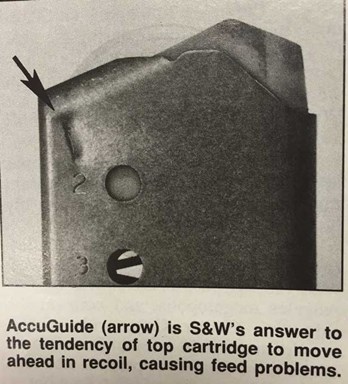
If 10 mm ammunition development continues in the current direction, we may well see a reprise of the old .38 Spl./.357 Mag. situation where properly chambered pistols can fire either a moderate load or the more powerful ammunition, depending upon the situation. If this comes to pass, the ammunition manufacturers will likely provide some means to easily distinguish the different loads, as both will use the same cartridge case.
I am sure by now some of you are wondering why the FBI did not simply adopt the .45 ACP, since it performed equally well in FBI testing. I posed this question to John Hall and Urey Patrick of the FTU. The answer is complex but revolves around two major points and several minor ones.
“Based on our test results, we could probably have gone with the .45 and been happy with it, but the 10 mm has a lot of, as yet, undeveloped potential,” Hall said. “We view it as an entry-level cartridge with other options and would not be at all surprised to see our ammunition preference change as testing progresses.”
The second consideration takes into account the human factor.
“One of the main factors in the choice of the 10 mm was an intangible based on individual preferences,” the FBI's Hall said. “Many agents were strongly committed to the 9 mm and others to the .45. The 10 mm provides a compromise that both can accept more readily.”
Other factors in the decision were not given as much weight but were still significant. The standard magazine capacity will give one more round (10 for the 10 mm vs. nine with the .45), and the 10 mm has proven to be exceptionally accurate.
But as the issue of magazine capacity is a valid concern, the FBI has directed S&W to provide three different magazines for the 1076. Each agent will be issued five magazines. Two will be the standard nine-round style, two will hold 11 and the third 15. In practice, an agent will carry the pistol with a nine-round magazine in place with two 11- round magazines in a belt carrier. He will have the option of inserting one of the larger magazines if trouble threatens.
S&W has also found an innovative solution to a problem that can occur in automatic pistols, especially those with heavier recoil. It is common for the top round in the magazine to move forward under recoil, with the bullet nose resting against the barrel ramp or frame. In this position it may not feed properly.
S&W's solution, called AccuGuide, consists of two strategically placed dimples on either side of the magazine just below the top. The dimples hold the rim of the top cartridge to prevent it from moving forward and are slightly angled so the case rim is guided into position as the magazine spring pushes it up. This feature is already standard on 10 mm magazines and will be phased into the production of other center-fire pistol magazines.
For purposes of comparison, both the Models 1006 and 1076 were fired with the same ammunition. Since the loads used are quite new, they deserve further mention.
The Federal XM1001 ammunition is specifically loaded for the FBI with the 180-gr. Sierra JHP bullet. Federal also has a 10 mm load in its Premium HydraShok line. This load uses a 180-gr. bullet as well, although it is of the patented Hydra-Shok design. Since the FBI ammunition is not available for commercial sale, the Hydra-Shok load will fill the need for someone who wishes to have a load that duplicates the performance of the special FBI ammunition.
The third load, Hornady's new 200- gr. hollow point, is that firm's response to the FBI ammunition study. Hornady has coined a new term, Extreme Terminal Performance (XTP), to identify bullets that have been redesigned with the goals of the FBI ammunition study in mind. It is the first 200-gr. hollow point to appear in 10 mm form, and although the 200-gr. bullet weight has been used before, those have been full-metal- jacket bullets.
Anyone who has fired a 10 mm pistol knows that it can be a handful in the recoil department, and it doesn't take much shooting to have had all the fun you want with standard ammunition. Recoil of the special FBI load and Federal's new Hydra-Shok is mild and manageable by comparison.
Even though the Model 1006 is a bit heavier, due to its longer barrel, there really is no difference in felt recoil between it and the Model I 076. Both are pleasant to shoot with the lighter loads.
It is very difficult to describe the sensation to readers who haven't had the opportunity to shoot one of the lighter loads. The recoil seems, to me, less than .45 ACP ball ammunition. The recoil of Hornady's 200-gr. load is sharper than either of the special loads.
As you can see from the accompanying tables, accuracy was excellent. Both pistols averaged slightly over 2" in our tests. The 10 mm cartridge has a reputation for high-level accuracy potential, and it is to S&W's credit that it has produced a reliable pistol capable of utilizing that potential. During extensive firing tests of both pistols, no malfunctions were encountered.
These two pistols may amount to the tip of the 10 mm iceberg from S&W, and it is logical to assume that model variations will appear with some frequency. The experience gained by the FBI, coupled with what is sure to become a whole range of new pistols, may well change the way law enforcement agencies all over the country think about handguns.
There probably is little need for the full-charge 10 mm ammunition in a defense or law enforcement pistol, for the FBI load has proven itself through the Bureau's comprehensive test to be almost equal to the more powerful full-charge 10 mm load without the distinct negatives of recoil and muzzle blast.
